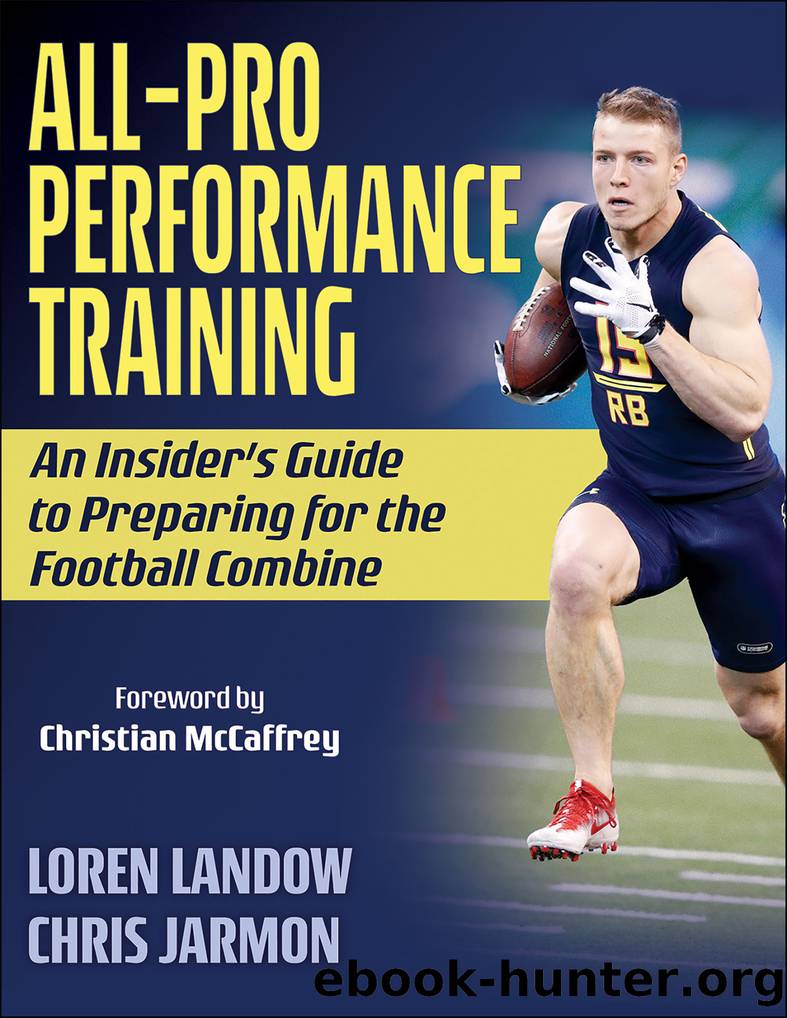All-Pro Performance Training by Loren Landow

Author:Loren Landow
Language: eng
Format: epub
Publisher: Human Kinetics
The partner or coach holding the belt should treat the A-run similarly to the A-march. His goal is to hold the athlete up and move at a pace that maintains the athleteâs starting body lean throughout the drill. His resistance should force the athlete to push back into the ground but should not prevent the athlete from moving forward. Meanwhile, the athlete should focus on his posture, position, placement, and patterning rather than trying to pull his partner forward like a sled or a parachute. This drill is about practicing the four Ps, and it should look like a smoothly moving wall drill with fast-paced leg action and arm swing.
The athlete completes an A-run for 5 yards moving out, then switches out of the belt and holds it while his partner completes a 5-yard repetition moving back to the starting line. Each athlete completes 3 or 4 A-runs for a single set. If the coach is holding the belt, the athlete gets rest intervals similar to those he would get if he had an active partner.
Coaching Points
Although the patterning of this drill is not quite the same as an unresisted sprint, it begins to approach that level of tempo. An athlete who can pattern well during a resisted A-run will generally be able to do the same in true acceleration.
TWO-POINT ACCELERATION START
Execution
Landow Performance combine preparation athletes typically use a two-point starting stance to practice acceleration. This position is more applicable to football and to sport in general. Although three-point stances are certainly common in football, they are much more sport-specific and do not fully mimic the starting position for a 40-yard dash. In competition, football players start from a true three-point acceleration stance only during their combine and pro day testing. Accelerating out of a three-point stance is more difficult, so the two-point start is meant to groove acceleration pattern acquisition and build relative strength that can then be transferred into the three-point start during 40-yard dash preparation. Athletes who struggle with other drills should still practice two-point starts because sprinting can often help them work through problems that donât make sense to them in drilling.
To set up in a two-point stance (figure 7.7), the athlete stands tall with both feet together at the line and his toes pointed straight ahead, emphasizing posture. He brings his right foot back behind his left and opens his back foot out to the right side so that his toes point to the right with his heels meeting at a 90-degree angle. From here, he keeps his left foot in place and pivots his right foot on his toes to swing his right heel out and bring his feet parallel again but now a footâs width apart. He wiggles his right foot along the ground another 6 to 8 inches back, based on comfort level and limb length. (Athletes with long legs should lengthen the distance between their front and back feet to accommodate their dimensions.)
Figure 7.7â â â Setup for acceleration from a two-point stance.
Download
This site does not store any files on its server. We only index and link to content provided by other sites. Please contact the content providers to delete copyright contents if any and email us, we'll remove relevant links or contents immediately.
The Plant-Based Athlete by Matt Frazier(501)
Functional Training and Beyond by Adam Sinicki(449)
Powerbuilding Breakdowns by Josh Bryant & Adam benShea(431)
Training for the New Alpinism by Steve House Scott Johnston Mark Twight(405)
Kung Fu: Grading & Training - Your Ultimate Summary Guide! (Wing ChunWing Tsun Styles) by Phil Pierce(371)
Calisthenics for Beginners by Grant Matthew(365)
Level Up: The fitness professional's road map to achieving excellence by Mark Coles(346)
Chi running by Danny Dreyer; Katherine Dreyer(338)
MotoJitsu Master Riding Program Volume 2 by Greg Widmar(326)
CALISTHENICS FOR BEGINNERS: Complete Step by Step Workout Guide to Build Strength with 50 Exercises and Pictures by Richard Anthony(323)
The Essential Karate Book by Graeme Lund(319)
Triathlon For Beginners: Everything you need to know about training, nutrition, kit, motivation, racing, and much more by Dan Golding(316)
Master The Kettlebell: How To Develop High-Level Skills In Movement, Power Generation And Strength--Using The World's Single Best Tool For The Job by Max Shank(309)
Workouts for Women: 2 Books in 1: Strength Training and Yoga for Beginners by Smith Jennifer & Jackson Hailey(309)
Survival by Navy Seal Workout(308)
CALISTHENICS FOR BEGINNERS: The Beginner's Guide to Strength Training Through Calisthenic Workouts by Miller Josh(307)
Essential Sports Medicine by Unknown(303)
Strength Training with Dumbbells: 50+ Exercises to Build Muscle, Burn Fat and Sculpt your Body at Home (Fitness Sutra Book 3) by Dr. Monika Chopra(300)
Strength Training by unknow(295)
